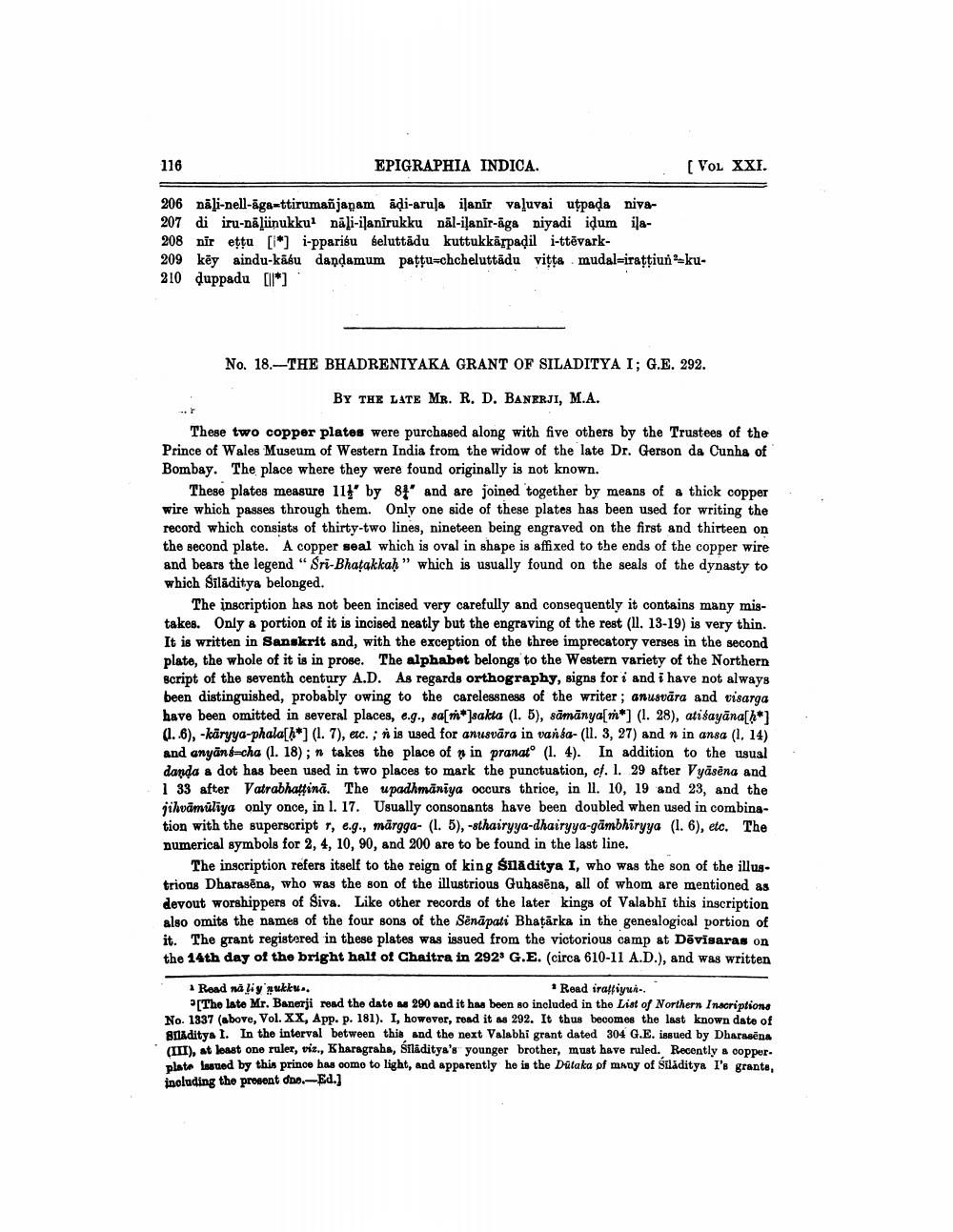________________
116
EPIGRAPHIA INDICA.
[VOL XXI.
206 nāļi-nell-āgaettirumañjanam ādi-aruļa ilanir vaļuvai utpada niva207 di iru-näliinukkui näli-ilanīrukku näl-ilanir-äga niyadi idum ila208 nirettu [i*] i-ppariģu beluttādu kuttukkārpadil i-ttēvark209 kēy aindu-kābu dandamum pațţu=chcheluttādu viţta mudal-irațțiun ku210 duppadu [ll*]
No. 18.-THE BHADRENIYAKA GRANT OF SILADITYA I; G.E. 292.
BY THE LATE MR. R. D. BANERJI, M.A.
These two copper plates were purchased along with five others by the Trustees of the Prince of Wales Museum of Western India from the widow of the late Dr. Gerson da Cunha of Bombay. The place where they were found originally is not known.
These plates measure 111' by 87" and are joined together by means of a thick copper wire which passes through them. Only one side of these plates has been used for writing the record which consists of thirty-two lines, nineteen being engraved on the first and thirteen on the second plate. A copper seal which is oval in shape is affixed to the ends of the copper wire and bears the legend " Sri-Bhatakkah” which is usually found on the seals of the dynasty to which Sīlāditya belonged.
The inscription has not been incised very carefully and consequently it contains many mistakes. Only a portion of it is incised neatly but the engraving of the rest (11. 13-19) is very thin. It is written in Sanskrit and, with the exception of the three imprecatory verses in the second plate, the whole of it is in prose. The alphabet belongs to the Western variety of the Northern script of the seventh century A.D. As regards orthography, signs for i and i have not always been distinguished, probably owing to the carelessness of the writer ; anusvāra and visarga have been omitted in several places, e.g., sa[*]sakta (1. 5), sāmānya[**] (1. 28), ati śayāna[h*1 0..6), -käryya-phala[h*] (1. 7), etc. ; n is used for anusvāra in vanda-(11.3, 27) and n in ansa (1. 14) and anyāns-cha (1. 18); n takes the place of min pranato (1. 4). In addition to the usual danda a dot has been used in two places to mark the punctuation, cf. 1. 29 after Vyāsēna and 1 33 after Vatrabhatină. The upadhmāniya occurs thrice, in 11. 10, 19 and 23, and the jihvāmūliya only once, in l. 17. Usually consonants have been doubled when used in combination with the superscript T, e.g., märgga- (1. 5), -sthairyya-dhairyya-gāmbhiryya (1. 6), etc. The numerical symbols for 2, 4, 10, 90, and 200 are to be found in the last line.
The inscription refers itself to the reign of king Snaditya I, who was the son of the illustrions Dharasēna, who was the son of the illustrious Guhasēna, all of whom are mentioned as devout worshippers of Siva. Like other records of the later kings of Valabhi this inscription also omits the names of the four sons of the Sēnāpati Bhatärka in the genealogical portion of it. The grant registered in these plates was issued from the victorious camp at Dāvisaras on the 14th day of the bright halt of Chaitra in 292% G.E. (circa 610-11 A.D.), and was written
* Read na liy nukku..
* Read iraftiyui. orThe late Mr. Banerji read the date m 290 and it has been so included in the List of Northern Inscriptions No. 1337 (above, Vol. XX, App. p. 181). I, however, read it as 292. It thus becomes the last known date of Boditya I. In the interval between this and the next Valabhi grant dated 304 G.E. issued by Dharasena (INT), at least one ruler, viz., Kharagraha, Siladitya's younger brother, must have ruled. Recently a copper. plate Issued by this prince has come to light, and apparently he is the Dulaka of many of Siladitya I's grants, including the present dno.--Ed.)




